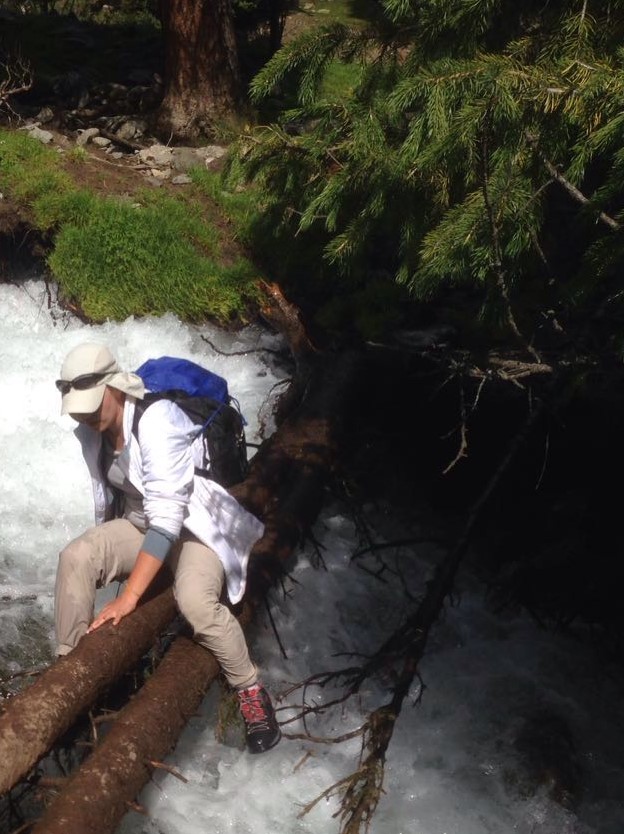Outdoors and sports clothing

Not every outdoor activity requires special clothing, but ones that do can be greatly improved in terms of wearer experience by choosing the right kinds of outfits. Before choosing the most appropriate hiking clothes it is important to take a specific trip parameters into consideration – type of the trip, expected temperatures and weather and how long it would be in terms of both time and distance. Similar advise can be given for sports clothing, consider type of sport, intensity and timing of your intended activities.
Common materials and fabrics
Commonly outdoor hiking cloths are made of nylon, spandex, polyester and other typically synthetic fabrics and blends. Cotton can be used for outdoor applications when we do not expect high moisture or rain, as cotton clothes do not dry as quickly as it's synthetic counterparts. Most animal based fabrics are even less suited for it then cotton, that's why animal derived hiking clothing are quit rare, yet they do exist so we always should check the components before we buy.
Please check out our article for more info on thermal and waterproof textile technology.
Because we at this site are against hunting and fishing, there will not be any advise given on hunting/fishing clothing and equipment in this article.
Here are some more details and advise on most common products:
- Hiking pants
- You don't have to hike wearing special pants, especially when it comes to moderate walk in nature any durable and comfortable pants will do. That being said, specializing hiking pants do offer some nice features for some hiking situations. Typically we require for hiking pants to be light weight, comfortable, durable, breathable, quickly drying and sun-protective. Synthetic fabrics are optimal choice that offer all those features. Commonly hiking pants will be made of nylon, polyester, spandex, synthetic blends and rarely cotton or cotton blended fabrics. We should note that rare blends include wool fibers to the fabric as well.
Some hiking pants are equipped with thin zipper above the knee so you can easily convert your hiking pants into a hiking shorts. Remember that wearing shorts exposes your legs to sunburns and scratches from plants you will walk though on your hike. While choosing your favorite pair of hiking pants you should also make sure that amount and location of pockets is comfortable and appropriate for you. - Sports pants and shorts
- Sports pants and shorts should be produced from breathable, light, moisture evaporating, soft and comfortable fabric, it may also need to be warming if intended for cold weather outdoor sports. There are many materials to choose from for your sports pant, most are synthetics like polyester, spandex, nylon, polypropylene, or natural fibers like bamboo or blends of above mentioned materials. Cotton on the other hand isn't the best option. It will trap sweat and moisture due to it's high moisture absorbance, making you stay wet and uncomfortable. Most likely animal based alternative used in this category is wool made of different animals, merino wool especially. Please make sure you aren't buying it.
- Hiking shirts
- Same as with hiking pants, you do not required to wear specialized hiking shirt for you trek or hike. It depends on the nature of your trip and your personal decision. We assure you that most of the times you will not feel any difference wearing your regular comfortable weather appropriate shirt to your hike. Of coarse hiking shirts offer us some qualities that not every other ones would, they are typically sun protective, light, comfortable, breathable, fast drying and durable. As we had mentioned above those features are best offered by synthetic fabrics, like nylon, polyester, spandex and synthetic blends. Rarely cotton or cotton blended fabrics are used, and even wool (especially merino wool) made shirts exist especially for warmer hiking shirts. Please beware, check the label to insure your purchases are animal friendly.
While choosing sleeve length of your shirt you should note that how hot it is isn't the only consideration as short sleeves will leave your arms exposed to sunburns and scratches from plants you may and probably will come in contact during your hike. - Sports shirts
- Whether for inside or outdoor sports activities, hot or cold weather, running or playing sports with your friends, sports shirt will always be useful. There are many materials to choose from for your sportswear, here we will count the more common and suitable ones. Although cotton sportswear clothes are produced, cotton most likely isn't the best choice for athletic shirt. It will trap sweat and moisture due to it's high moisture absorbance, making you stay wet and uncomfortable. The best materials are soft, lightweight, breathable and moisture wicking. Many materials have those properties: synthetics like polyester, spandex, nylon, polypropylene, natural fibers like bamboo or blends of above mentioned materials.
- Sports bra
- Sports bras have to be breathable, comfortable and supportive of the breasts during physical exercise. While bra's padding should be designed for required support, type of fabric is the most important factor for other desired features. Moisture-wicking fabrics like nylon, spandex, polyester and their blends are your best choices. Cotton, although fairly popular in sports bra design, will make you feel uncomfortable as it absorbs moisture and therefore will trap the sweat during your exercise.
- Socks
- The best socks will be made of soft and breathable materials, will dry fast when wet and have an antibacterial properties. Synthetic materials are the best fit again, fabrics like nylon, spandex, olefin, polyester, polypropylene, acrylic or blended synthetic fabrics are your best choices. Cotton, linen and other plant based fabrics can make great outdoor socks too. Wool is frequently used for thermal outdoor socks and rarely for other outdoor socks as well. Please check product's label shopping if it is important for you to reduce animal suffering associated with textile industry.
- Jackets
- Outdoor jacket should be breathable, waterproof and warm. In some cases, for example during cold winter nights, during mountains trekking and hiking, when it is snowing, even have some thermal properties - thermal and waterproof textile technology. Best animal friendly materials available are: vinyl (PVC), polyurethane, elastic silicone and blended synthetic or synthetic and plant based fabrics. Somewhat used animal derived materials include silk, wool and fur – they are less suited for most outdoor usage, please make sure you're not purchasing those on your next shopping trip if you believe in our cause to reduce unnecessary animal suffering as much as possible.
Sometimes simple fleece jacket can do the trick. It is not water-proof so bring a rain coat in addition to the fleece if you're expecting rain during your hike. - Rain coats
- Rain coat can be a big help during your hike. Rain coats should be water proof, comfortable enough and durable, made of fabrics like nylon, polyester, rayon and vinyl.
- Motorcycle jackets
- The most important aspect of motorcycle jackets is the safety it provides to a motorcyclist, fashion in this case only comes second. Motorcycle jackets are frequently produced from an animal leather. There are, however, great animal friendly motorcycle jackets available on market, for example jackets made of faux/synthetic leather, those made of polyurethane, vinyl or nylon. We encourage you to choose your jacket out of those options, rather then ones made of an animal leather.
Summary and some more advise
While you're preparing for hiking, especially when you planning to go overnight and up the mountains you should prepare for a temperature drop. One of the best ways is to bring couple of extra layers of clothes with you, that way you can take them off when it's hot and put them on if you're cold. We suggest bringing or wearing a t-shirt, one long sleeve thin shirt, fleece shirt and warm jacket if needed, depending of the expected temperatures. Remember, you will only enjoy your hike or athletic activity more if you are comfortable doing it, and your clothes play a significant role in that.
As always we remind you about an important ethical issues you should keep in mind, such as animal suffering, human working conditions and environmental sustainability. As a general rule, vegan, recycled and organic brands frequently are more environmentally friendly and will offer a better solution. Our awareness of those issues will push textile industry one step further in solving them. Please keep those issues in mind during your next shopping trip before your paying for your next outdoor sports or hiking clothes.
